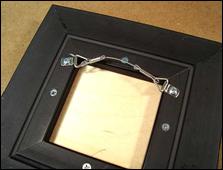 Photo 1
Photo 1
Snap-in clips are placed slightly more than ¼ down from top of metal frame.
Placement of wire hangers—D-rings, steel plates, snap-in clips, and screweyes—AND the length of the wire both greatly impact the display results of any frame. The idea behind proper placement of hangers and wire length is to prevent increased stress on the side legs of the frame. Placement of hangers should be ¼th (photo 1) to ⅓rd (photo 2) full height from top of the frame.
 Photo 1
Photo 1
Snap-in clips are placed slightly more than ¼ down from top of metal frame.
 Photo 2
Photo 2
D-rings are placed ⅓rd from top of wood frame.
Regardless of the wire selected (Wax-On, "Which Wire?", June 2011) it should be cut long enough to extend about half way from horizon line—between the hooks—to the top of the frame when fully installed (photo 3). Less is more is the best practice when installing wire. The extended wire length (photo 4) is not better but would allow the frame to tilt forward if hung on a single wall hook, and if two hooks are used the wire would interfere with the top of the stretched canvas. Since two wall hooks are always advised for installation—to help spread the weight and relieve wire and side frame stresses—they must also be placed as not to interfere with the art. And just an aside—use of only two offset clips to hold the canvas into the frame is not enough. This will be discussed further in a future article.
 Photo 3
Photo 3
Installed wire should extend half way to top of frame.
 Photo 4
Photo 4
Wire is way too long hich allows the frame to tilt away from wall.
On the small 4x4" float frame (below) in photo 5 the D-ring hangers have been installed about ⅓rd distance from frame top but the wire is slightly tighter. As a frame gets smaller the weight is diminished—even with an encaustic painting—therefore the wire may be pulled tighter and flatter when installed. The proportion between the frame to the length of the wire can be significant especially with very small frames. Since there is no issue of side leg stress on this frame a tighter wire is not a problem and the flatter wire will allow for a flatter display against the wall.
 Photo 5
Photo 5
A tighter wire compensates for the smaller frame proportions.
Comments and questions are welcome and may always be sent to me at chris@DesignsInkArt.com and we can begin a monthly Q & A if you like. And as always—all WAX-ON Framing Matters articles are also available on my website https://www.DesignsInkArt.com in the special section for IEA on the Articles by Subject index page.
May I wish everyone a happy and healthy 2012, and thanks for reading.
END
Copyright © 2012 Chris A Paschke
For more articles on mounting basics look under the mounting section in Articles by Subject.
There is a special section in the library for all past IEA Framing Matters articles from Wax-On!
Additional information on all types of mounting is found in:
The Mounting and Laminating Handbook, Second Edition, 2002,
The Mounting And Laminating Handbook, Third Edition, 2008 and
Creative Mounting, Wrapping, And Laminating, 2000 will teach you everything you need to know about getting the most from your dry mount equipment and materials as an innovative frame designer.
All books are available from Designs Ink Publishing through this website.
Chris A Paschke, CPF GCF
Designs Ink
Designs Ink Publishing
785 Tucker Road, Suite G-183
Tehachapi, CA 93561
P 661-821-2188
chris@designsinkart.com